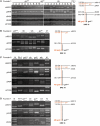Use of RecA fusion proteins to induce genomic modifications in zebrafish
- PMID: 21266475
- PMCID: PMC3105420
- DOI: 10.1093/nar/gkq1363
Use of RecA fusion proteins to induce genomic modifications in zebrafish
Abstract
The bacterial recombinase RecA forms a nucleic acid-protein filament on single-stranded (ss) DNA during the repair of double-strand breaks (DSBs) that efficiently undergoes a homology search and engages in pairing with the complementary DNA sequence. We utilized the pairing activity of RecA-DNA filaments to tether biochemical activities to specific chromosomal sites. Different filaments with chimeric RecA proteins were tested for the ability to induce loss of heterozygosity at the golden locus in zebrafish after injection at the one-cell stage. A fusion protein between RecA containing a nuclear localization signal (NLS) and the DNA-binding domain of Gal4 (NLS-RecA-Gal4) displayed the most activity. Our results demonstrate that complementary ssDNA filaments as short as 60 nucleotides coated with NLS-RecA-Gal4 protein are able to cause loss of heterozygosity in ∼3% of the injected embryos. We demonstrate that lesions in ∼9% of the F0 zebrafish are transmitted to subsequent generations as large chromosomal deletions. Co-injection of linear DNA with the NLS-RecA-Gal4 DNA filaments promotes the insertion of the DNA into targeted genomic locations. Our data support a model whereby NLS-RecA-Gal4 DNA filaments bind to complementary target sites on chromatin and stall DNA replication forks, resulting in a DNA DSB.
Figures






References
-
- McGrew DA, Knight KL. Molecular design and functional organization of the RecA protein. Crit. Rev. Biochem. Mol. Biol. 2003;38:385–432. - PubMed
-
- Radding CM, Shibata T, DasGupta C, Cunningham RP, Osber L. Kinetics and topology of homologous pairing promoted by Escherichia coli recA-gene protein. Cold Spring Harb. Symp. Quant. Biol. 1981;45(Pt 1):385–390. - PubMed
-
- Cox MM. Recombinational DNA repair in bacteria and the RecA protein. Prog. Nucleic Acid Res. Mol. Biol. 1999;63:311–366. - PubMed
-
- Campbell MJ, Davis RW. On the in vivo function of the RecA ATPase. J. Mol. Biol. 1999;286:437–445. - PubMed
Publication types
MeSH terms
Substances
Grants and funding
LinkOut - more resources
Full Text Sources
Other Literature Sources
Molecular Biology Databases

